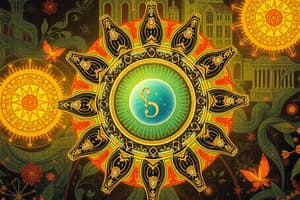Podcast
Questions and Answers
What is the energy called that is required to break the nucleus apart?
What is the energy called that is required to break the nucleus apart?
- Fission energy
- Nuclear energy
- Radiant energy
- Binding energy (correct)
Which process involves the splitting of a heavy nucleus?
Which process involves the splitting of a heavy nucleus?
- Nuclear fusion
- Nuclear fission (correct)
- Nuclear condensation
- Nuclear decay
What is a significant requirement for nuclear fusion to occur?
What is a significant requirement for nuclear fusion to occur?
- Low temperatures and pressures
- Absorption of a neutron
- Presence of radioactive isotopes
- High temperatures and pressures (correct)
How is the mass defect related to energy according to Einstein's equation?
How is the mass defect related to energy according to Einstein's equation?
What is one application of nuclear technology in medicine?
What is one application of nuclear technology in medicine?
What determines the atomic number of an element?
What determines the atomic number of an element?
Which force is primarily responsible for binding protons and neutrons together in the nucleus?
Which force is primarily responsible for binding protons and neutrons together in the nucleus?
What is the process called when a heavy nucleus splits into smaller nuclei, releasing energy?
What is the process called when a heavy nucleus splits into smaller nuclei, releasing energy?
Which type of radioactive decay involves the emission of gamma rays?
Which type of radioactive decay involves the emission of gamma rays?
What is the primary significance of studying nuclear physics?
What is the primary significance of studying nuclear physics?
What happens to the mass of a nucleus in comparison to the total mass of its protons and neutrons?
What happens to the mass of a nucleus in comparison to the total mass of its protons and neutrons?
Which type of force is responsible for the repulsion of protons within the nucleus?
Which type of force is responsible for the repulsion of protons within the nucleus?
In the fusion process, what primarily happens to light nuclei?
In the fusion process, what primarily happens to light nuclei?
Flashcards
Nuclear Physics
Nuclear Physics
The study of atomic nuclei, their forces, and reactions.
Atomic Structure
Atomic Structure
Atoms are made of protons, neutrons, and electrons; protons and neutrons form the nucleus.
Atomic Number (Z)
Atomic Number (Z)
The number of protons in an atom's nucleus defines the element.
Mass Number (A)
Mass Number (A)
Signup and view all the flashcards
Isotopes
Isotopes
Signup and view all the flashcards
Radioactivity
Radioactivity
Signup and view all the flashcards
Nuclear Fission
Nuclear Fission
Signup and view all the flashcards
Nuclear Fusion
Nuclear Fusion
Signup and view all the flashcards
Mass Defect
Mass Defect
Signup and view all the flashcards
Binding Energy
Binding Energy
Signup and view all the flashcards
Nuclear Medicine
Nuclear Medicine
Signup and view all the flashcards
Study Notes
Introduction to Nuclear Physics
- Nuclear physics studies the structure and behavior of atomic nuclei.
- It examines forces binding protons and neutrons within the nucleus and processes altering the nucleus.
- Phenomena explored include radioactivity, nuclear reactions, fission, and fusion.
- Understanding nuclear physics is crucial for cosmic phenomena (star formation) and power generation.
Atomic Structure
- Atoms comprise protons, neutrons, and electrons.
- Protons and neutrons form the nucleus.
- Electrons orbit the nucleus in energy levels.
- The atomic number (Z) equals the number of protons, defining the element.
- The mass number (A) is the sum of protons and neutrons.
- Isotopes share the same element but differ in neutron count.
Nuclear Forces
- The strong nuclear force binds protons and neutrons within the nucleus.
- It surpasses the electromagnetic force at short distances, but has a limited range.
- The electromagnetic force repels positively charged protons.
- The weak nuclear force drives certain radioactive decays.
Radioactivity
- Radioactivity is the spontaneous emission of particles or energy from unstable nuclei.
- Unstable nuclei are termed radioactive isotopes.
- Types of radioactive decay include: alpha decay (alpha particle emission), beta decay (beta particle emission), and gamma decay (gamma ray emission).
- Each decay modifies the nucleus, promoting a more stable configuration.
Nuclear Reactions
- Nuclear reactions modify the atom's nucleus.
- Reactions can be induced by bombarding the nucleus with particles.
- Fission involves the splitting of a heavy nucleus into smaller ones, releasing significant energy, used in power plants.
- Fusion unites light nuclei into a heavier one, releasing even more energy, powering stars.
Mass Defect and Binding Energy
- Nuclei have less mass than their individual proton-neutron constituents.
- This mass difference is called the mass defect.
- Mass defect converts to energy according to E=mc².
- This energy is binding energy, the energy needed to fragment the nucleus.
- Higher binding energy correlates with a more stable nucleus.
Nuclear Fission
- Fission splits a heavy nucleus into lighter ones, releasing substantial energy.
- Fission powers nuclear power plants and atomic bombs.
- Neutron absorption often triggers the fission process.
- Chain reactions are crucial in fission processes.
Nuclear Fusion
- Fusion merges light nuclei into a heavier one, releasing immense energy.
- Fusion powers the sun and other stars.
- High temperatures and pressures overcome nuclear repulsion in fusion reactions.
- Controlled nuclear fusion on Earth is an ongoing research area.
Applications of Nuclear Physics
- Nuclear medicine utilizes radioactive isotopes for diagnostics and treatments.
- Nuclear power plants leverage fission for electricity generation.
- Nuclear technology applies to various industries like materials science, agriculture, and archaeology.
- Radiometric dating uses radioactive isotopes to determine age.
Studying That Suits You
Use AI to generate personalized quizzes and flashcards to suit your learning preferences.




